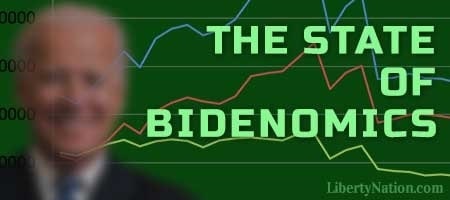President Joe Biden is putting all his eggs in the Bidenomics basket, betting everything he has on the doctrine that has resulted in 40-year-high inflation, surging gasoline prices, soaring debts and deficits, two-decade-high interest rates, and everything else that currently plagues the US economy. But while the current administration keeps championing its record and proclaiming that it is superior to President Donald Trump, the statistics tell a different story – especially when they are accurately put together. So, let’s dive deeper into the tale of the tape and compare the results of Bidenomics and Trumponomics in the first 30 months of each man’s presidency.
Bidenomics vs Trumponomics: The Labor Market
The White House has claimed ad nauseam that President Biden has created more than 13 million new jobs, higher than his predecessor. This is correct when taking one look at the Bureau of Labor Statistics (BLS) monthly employment data, but as the saying goes, the devil is in the details. The current administration is misleading the public by employing a simple trick of including positions returning from the pandemic in this data point. President Biden’s jobs record differs from that of the billionaire real estate mogul when this tactic is removed from the equation.
In the first 30 months of his presidency, Trump oversaw an economy that created a seasonally adjusted 5.034 million new jobs. By comparison, the incumbent has created 3.93 million new jobs. Manufacturing, the bread and butter of both Bidenomics and Trumponomics, performed better under Trump than Biden. The sector produced 446,000 positions during Trump’s first 30 months, while the industry added 196,000 under the current president. This is notable, too, because Biden has signed three key pieces of legislation – the Inflation Reduction Act, the Bipartisan Infrastructure Law, and the CHIPS and Science Act – that are paramount to manufacturing.
But Bidenomics enjoys an advantage over Trumponomics and can squeak out a victory in two labor-related areas. The first is the jobless figure. By the end of the former president’s 30 months, the unemployment rate stood at 3.7%. Today, it is 3.5%. The second is real (inflation-adjusted) disposable personal income, which presently stands at $46,795. After Trump’s 30th month, it was $44,991.
Bidenomics vs Trumponomics: Cost of Living

(Photo by Scott Olson/Getty Images)
Inflation has been a significant challenge for the current president. Sky-high prices have defined Bidenomics, and the dramatic jump will forever be baked into the marketplace. There is no going back. Since Biden’s inauguration, cumulative price inflation has skyrocketed more than 15%. During Trump’s first 30 months, cumulative inflation was around 4%. There was also a substantial gap between the two presidents in three key categories: food, energy, and rent.
Under Biden, food has soared about 18%, energy has climbed 37%, and rent has risen roughly 13%. Under Trump, food costs rose by close to 4%, energy edged up less than 2%, and rent swelled by 7.5%.
When administration officials assess gasoline prices, they tend to only look at when the war in Eastern Europe broke out. They refuse to examine the cost of a gallon of gas from January 2021 to January 2022. At the end of Trump’s 30th month, the national gasoline average was $2.73. When Trump left office and Biden was sworn in, the price at the pump was below $2.40 per gallon. Although they are down from their June 2022 peak of $5.02, gasoline prices are up 61% since 2021 to $3.87 per gallon, according to the American Automobile Association (AAA).
A chief aspect of the American Dream is homeownership. Unfortunately, for millions of millennials and Generation Zers, they can only see themselves owning a home in their sleep. The big issue is affordability. Today, the median sales price for residential properties sold in the US is more than $416,000, with an average 30-year mortgage rate of approximately 7%. Under Trump, home prices held steady, coming in at $318,400 by the middle of 2019 (roughly unchanged from when he took office), with an average 30-year mortgage of 2.6%.
 Overall, the percentage of Americans living in poverty tumbled to 10.5% in 2019, with real household incomes climbing to a record high of $72,808, according to data from the Census Bureau. To be fair to Biden, the federal agency does not regularly update this figure, but it noted in January 2023 that the poverty rate climbed to nearly 12% in 2021, and real household incomes dropped to $70,784.
Overall, the percentage of Americans living in poverty tumbled to 10.5% in 2019, with real household incomes climbing to a record high of $72,808, according to data from the Census Bureau. To be fair to Biden, the federal agency does not regularly update this figure, but it noted in January 2023 that the poverty rate climbed to nearly 12% in 2021, and real household incomes dropped to $70,784.
Who Wins?
The US economy was performing quite well heading into the COVID-19 public health crisis. Sure, there were hiccups throughout the Trump economic landscape, but most everyone appeared to be doing well. The gains achieved under the 45th president will be ignored because the pandemic decimated everything, resulting in skewed data and history books reporting on the Trump years unkindly. Indeed, this is what President Biden and the mainstream media will bank on throughout the 2024 election, for instance claiming the Trump economy lost nearly three million jobs. However, by comparing the economic records of Bidenomics and Trumponomics in their respective first 30 months, the numbers suggest the Trump doctrine succeeded far better than what Biden is doing.




